Alright everyone, here are the results from the 2022 Warhammer “X-Edition” Survey. As a reminder, the purpose of this survey was to reflect back on editions past and current in an effort to understand the overall perception of each edition of
40k and shine a light on what people liked or didn’t like about a given edition. There’s no shortage of conversation across online
40k communities about what worked well (or not), and this survey is an opportunity to put some numbers behind the discussion.
-------------------------------------------------------------
Basic information about the survey: Survey opened: September 2, 2022
Survey closed: September 30, 2022 (last submission Sept 28)
Responses: 397
-------------------------------------------------------------
Broadly, the survey asked questions across the following categories:
Player/Community Demographics Included questions related to how they heard about the survey (e.g. dakka dakka vs reddit), the extent to which players are driven or motivated by competitive play, narrative play, or modeling aspects of the hobby. Also explores where players play, their frequency, and the format of games they play
Edition Plays & Cohorts Questions about the editions that players have played and the volume of games played under a given edition. The results of these questions are used to form players into “cohorts” of players that share a similar pattern of editions played. Cohorts are a useful way of exploring how different groups of respondents respond to certain other questions.
Armies Played (pending) Questions about what armies players played across a given edition. Full analysis is pending,
raw results can be viewed in the result viewer.
Edition Ratings These are questions that break down the “overall” ratings that players gave to editions of
40k. Ratings are based on a 1-5 scale, which can be translated into an index by assigning point value to the responses as follows:
-2 : Did not like it at all!
-1 : Take it or leave it, some parts okay, some parts bad
0: Decent but certainly not perfect
+1: Great overall, some minor quibbles
+2: Loved it! A favorite edition!
Game Aspects A series of ten (10) game aspects were identified, and respondents were asked to identify which aspects they DID LIKE for a given edition and what aspects they did NOT LIKE for a given edition. These aspects included:
* Core rules overall (clarity, depth, complexity)
* Codex complexity and structure
* Codex unit and option diversity, types of army lists
* Relative balance and power between factions
* Mission design and game formats
* Lore and fluffy rules
* Level of competitiveness / the competitive scene
* Narrative focused gameplay / campaigns
* Depth of tactics and strategy on the battlefield
* Strategy in assembling a strong army
Rule Opinions 41 different rules were listed, and respondents could rate how well they liked or disliked a given rule. In many cases, alternative rules were presented in side-to-side questions, in order to draw comparisons between preferences over a similar mechanical system that was handled using different rules across editions.
Here we go!
-------------------------------------------------------------
Player/Community Demographics -------------------------------------------------------------
First item is the breakdown of where people found out about the survey, a rough approximation for the different online communities respondents may be part of.
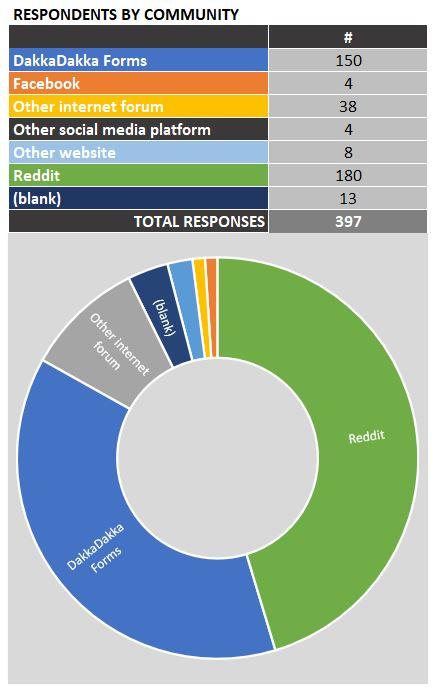
Reddit provided the largest group of respondents, after posting on r/warhammer and r/warhammercompetitive. But DakkaDakka was not too far behind.
I was interested in seeing if there was much of a difference between the two communities in terms of their overall tendency towards competitive versus narrative play, and the importance placed on modeling/painting. Hence the series of three charts below:
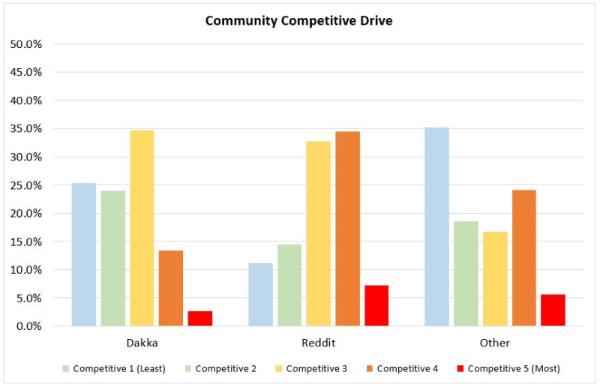
Reddit has almost triple the number of self-identified high competitive players (competitiveness 4 and 5) compared to DakkaDakka, which sees itself as less competitive. The numeric index for Reddit is 3.12 versus 2.44 for Dakka.

In contrast, when it comes to narrative play it leans more towards DakkaDakka, with DakkaDakka averaging 3.67 versus reddit at 3.18. Other communities average around 3.5.
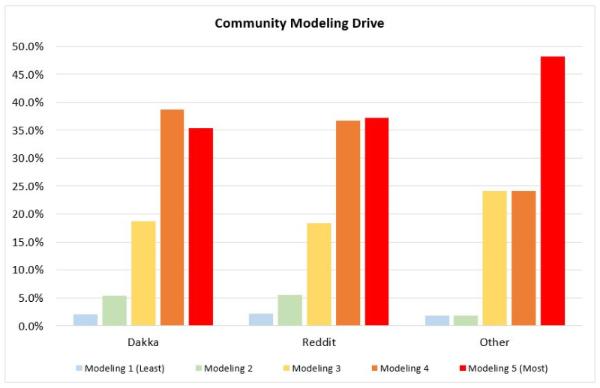
The last charts looks at the importance of painting and modeling as a driver for engagement in the hobby. This was actually the strongest factor across all three communities, with the average being over 4.0 for every community! This wasn't a result I was expecting - but I suppose it isn't too surprising at the end of the day.
-------------------------------------------------------------
Edition Plays & Cohorts -------------------------------------------------------------
There's a few thing to unpack here, so let's break it down.
First is a simple chart of which editions of
40k each respondent played. You can see the breakdown below and the % of total respondents that reporting playing each edition.
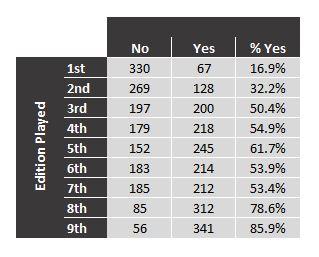
For context, it's important to note that over 85% of respondents played 9th edition, about 78% played 8th, and 3rd-7th edition hovered in the 50-60% range. 2nd edition was played by only a third of respondents (I'm surprised it was that high actually!) and over 16% had played rogue trader (even more surprised!).
It is worth pointing out that the higher rates of responses to questions pertaining to 9th edition have the potential to skew results, where the volume of results matters to the assessment. In many cases, scores and responses were "normalized" relative to the number of edition players, presenting %'s instead of direct numbers.
The next chart was a quick comparison looking at a given edition and seeing ow frequently players of that edition also played other editions. See below:
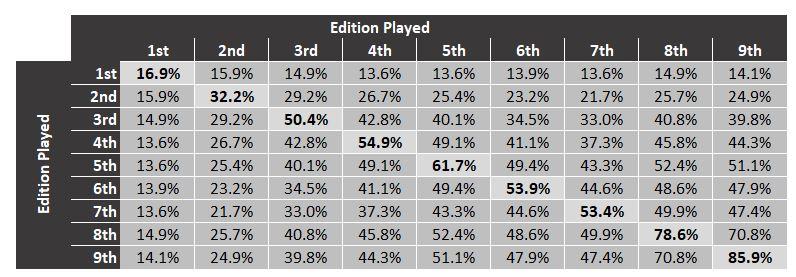
Ultimately, all of this information fed into the establishment of "cohorts" - which are different groups of respondents organized into unique, non-overlapping groupings, based the pattern of editions they had played.
The cohort breakdown is below:
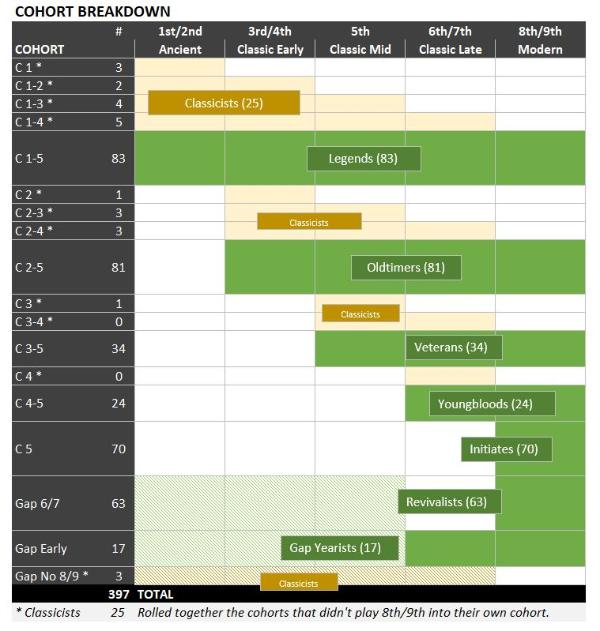
* Note the numbers in parenthesis indicate the number of respondents within each cohort.
Unsurprisingly, most people and most cohorts have played 8th/9th edition - and certainly there is some bias here as active players are the one's more likely to be in online
40k communities and apt to see the survey. So results for things do skew towards familiarity with 8th/9th edition.
The cohort descriptions are thus.
Legends: These are players that started with 1st or 2nd edition and have played across each era up to and included the modern 8th/9th ed era. Surprised to see so many 1st/2nd edition players
 Oldtimers
Oldtimers: Similar to above, but they missed out on 1st and 2nd edition. Players would've started in 3rd or 4th edition.
Veterans: Essentially the people that started in 5th edition and kept playing up through the current modern era.
Youngbloods: Started in 6th/7th edition (poor saps!) and stuck with it into the modern era.
Initiates: Started playing in 8th/9th. I'm surprised (but not surprised) that this cohort is as big as it is. There was a lot of buzz about 8th edition and big reset, and I think a lot of veteran players were roping newer players into the hobby, which may explain the relative size of this cohort despite the relative newness of the applicable editions.
Revivalists: This is a decent size cohort of people that are playing 8th/9th, but skipped 6th/7th after playing some combination of earlier editions/eras of
40k. Basically, it is older vets turned off by the churn and direction of 6th that dropped the game, only to come back in 8th or 9th edition.
Gap Yearists: People that played during 6th/7th and 8th/9th and in at least one or two other eras, but which had a "gap" somewhere in their history.
Classicists: These is the group of people falling into a range of different combinations (and is only 25 people in total) that haven't played 8th/9th edition at all, but have played some other combination of older editions that don't fall into any of the above categories.
-------------------------------------------------------------
Edition Ratings -------------------------------------------------------------
Here's (probably) the moment you've been waiting for. How do the editions stack up!?
First up is just the
raw responses broken down by the numbers of each response option, for each edition:

The bottom row of the chart lists the "weighted overall score" (which I sometimes call an index) for each edition. Values over 0.0 (positive numbers) are overall good ratings, whereas negative numbers are overall.... not good.
From this, we can see that 2nd edition (gasp!) was most liked, at a 0.50 index score. 3rd, 4th, and 5th edition were close behind however, at 0.47, 0.46, and 0.48 respectively.
6th and 7th edition dipped hard into the negative territory (-0.44 and -0.68 respectively).
8th and 9th edition were overall positive, but were quite a bit closer to the 0 zero mark (0.17 and 0.08 respectively).
My takeaway from this is that, especially for 9th edition, being the closest to "0" means that the community overall is fairly divided over the game. Yes, it leans slightly positive but the numbers of people that "don't like it at all" is very close to the number of people that "love it" - and these are fairly high quantities in both cases. This quantifies a bit of the tension and frustration we see in the community over 9th edition. This is quite a bit different compared to 7th edition, which a clear majority of people dislike for example.
Drilling further into these ratings, I wanted to understand more about "who" liked or disliked a given edition, which is where the cohorts come in.
The chart below assess the total edition rating score for each edition across each relevant cohort.
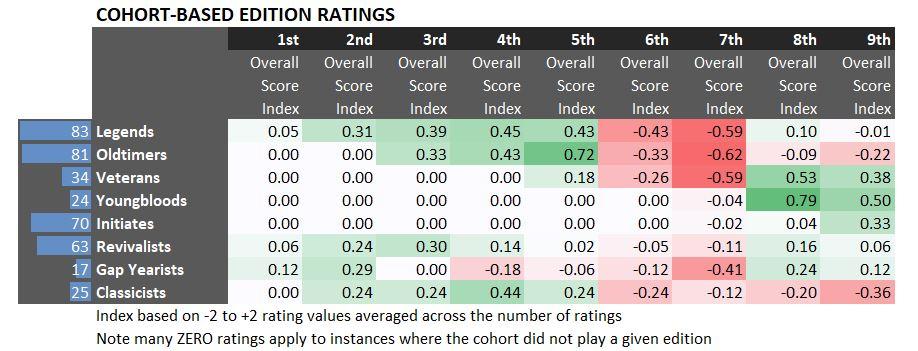
There are some strong and interesting observations to make about this data.
#1
In shifting from 8th to 9th edition, the rating went down for every cohort except the "initiates." The initiates are people that have only played 8th or 9th edition games. Given the relative streamlining that the 8th edition "reset" brought about, I wonder for this group (which doesn't have pre-8th experience) if the added refinements to the core rules coupled with more perceived depth and detail in the rules/codexes was seen as a positive. In contrast, for every other cohort that may have lived through a "bloat" phase in the rules, they perceived this complexity creep in a more negative light. This is speculation, but I think it's interesting.
#2
The Old-timers that started in 3rd/4th edition really liked 5th edition, with an index score of 0.72 (and this was the second highest positive index score). I see many expressing the sentiment of 5th being the "best" of the classic period and a highwater mark, and for people most rooted in the classic 3rd-7th edition eras, it's easy to see why they'd gravitate towards 5th. What's interesting however is that the Legends cohort favors 5th quite a bit less, and veterans that started in 5th score it even less.
#3
Speaking of veterans, this group is interesting, They started with 5th, yet didn't rate it all that high (0.18). 6th and 7th were of course negatively rated, but this group places 8th and 9th edition above 5th (and remember too 5th is the overall favored still).
#4
Similarly, the Revivalists and Gap Yearists place 8th and 9th a bit higher. For the Revivalists, 3rd edition was a highwater mark (preference for a newly streamlined gameplay?) and each subsequent edition went further and further downhill until 8th kicked things back up (only for it to go downhill again with 9th!).
#5
The classicists have a strong liking for 4th edition, and the biggest dislike of 8th and 9th edition of any cohorts. Technically, Classicists by their cohort definition should not be rating 8th/9th since they didn't play it to a significant degree. Maybe they are just haters on principal!
-------------------------------------------------------------
Game Aspects -------------------------------------------------------------
The game aspects questions will let us dig a little more into big picture aspects of why people did or didn't like a given edition. The charts presented below show the "net" positive (or negative) result for each aspect across each edition.
Aspects 1-5
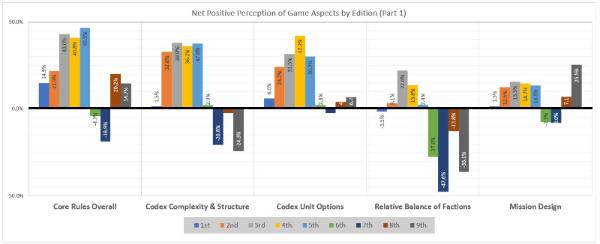
Unsurprisingly 6th and 7th fares poorly across the board.
In terms of balance, we see that 9th edition (and to a lesser extent 8th) trends negatively on "Relative Balance of Factions." I do sometimes wonder if balance discussions have become more angsty over the years and a source of complaint, or whether imbalances are just felt more under 9th edition because the game caters to and supports more of a "matched play" and competitive environment? Maybe? Balance was highest during 3rd edition and nearly neutral during 5th.
I think 9th edition should get kudos for its mission design, as clearly that's a strength of the edition, with the matched play, narrative, and open war missions providing some great formats. I feel like people are generally discussing the missions in a favorable light these days. Still, 2nd through 5th edition also scored relatively well.
I was surprised to see the classic 3rd-5th edition core rules score better than 8th/9th edition, despite my personal beef with the oversimplification of 8th/9th rules. But 3rd-5th was posting nearly double the net positive rating.
Another knock on 9th edition that stands out is the codex complexity and structure, which was quite low. 9th edition codexes give me a headache to read, so I concur with the results

Aspects 6-10
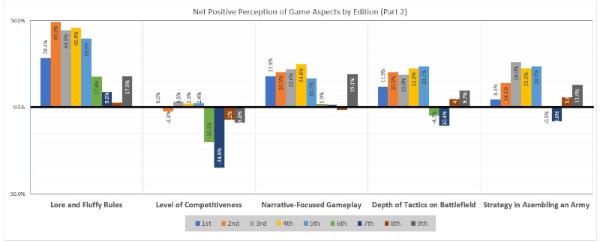
Here we go on the next set of 5 aspects.
Lore and fluffy rules puts 2nd edition at the top of the pile, although 3rd-5th wasn't far behind. I'm sort of surprised to see 9th edition (and 8th) being so much lower. There are a lot of rules layered into codexes, but maybe the feeling is that these aren't realty that thematically unique. A personal critique of mine is that a lot of the things in 9th that are passed off as "fluff" are really just the same set of die roll modifiers or re-roll triggers given a unique name. But I digress.
I was hoping that 9th would score higher on the narrative-focused gameplay, since the crusade system appears to be a well-loved method of play and is more of fully-featured progression that we've had before, with lots of campaign support for it. It scores about in the same range as 1st-5th edition.
Last, when it comes to battlefield tactics and army strategy, 8th and 9th score quite a bit below 3rd-5th edition on both fronts. 5th edition, for the record, has the highest "tactics on the battlefield" score, which aligns with much of the community sentiment when it comes to gameplay.
Aspects Overall
I think overall these aspects highlight some of the major perceived strengths and weaknesses across the editions, and help explain the overall ratings a bit more.
Of course, we can dig even deeper....
-------------------------------------------------------------
Rule Opinion -------------------------------------------------------------
In this section of the survey, it asked for people's reactions to specific mechanics in the rules, in many cases separate questions for ways that different editions handled a given mechanic (e.g., were charge distances fixed or variable based on rolling a
2D6, and which did people like/dislike). As a summary of this section, the chart below provides the total index score for each of the individual rules in question.
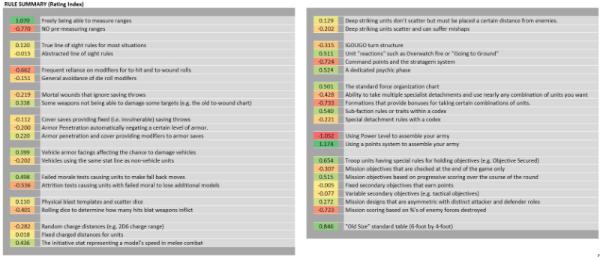
As with other indexes, positive numbers indicate a preference and good outlook towards the item, whereas a negative number indicates something people dislike overall.
Here's the detailed results:
MEASUREMENT METHODS
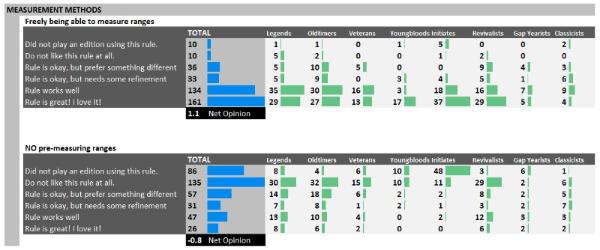
I'm a little surprised here. I assumed most people preferred freely measuring ranges, but I didn't think it would be quite such a stark contrast. Revivalists seemed to like it the most, relatively speaking, but overall was a negative for all groups.
LINE OF SIGHT METHODS
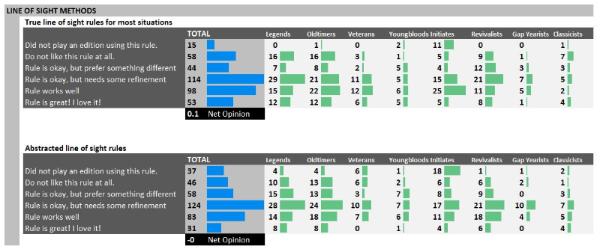
Lots of discussion happening below on Line of Sight. Overall, the results are quite close here, being slightly positive for
TLOS and slightly negative for more abstract. I think based on the discussion the truth is that the "devil is in the details" and there are things that make either approach work well or be totally broken. People clearly don't like
TLOS when you can shoot an antenna by drawing
LoS from tail pipe or whatever, but when
TLOS is working properly, I feel like it gets more favorable reception.
The reality too is that most editions have actually been a blending of the approaches in many ways.
DIE ROLLING METHODS
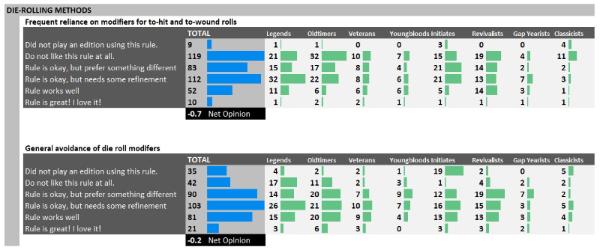
This one is interesting, because between the two big options, no one seems particularly enamored. The "general avoidance" of die roll modifiers is more preferred, but its still trending negative. Interestingly the "Legends" players really don't like avoiding modifiers - maybe because they cut their teeth with 1st/2nd edition that was chock full of them?
WOUNDING AND DAMAGE
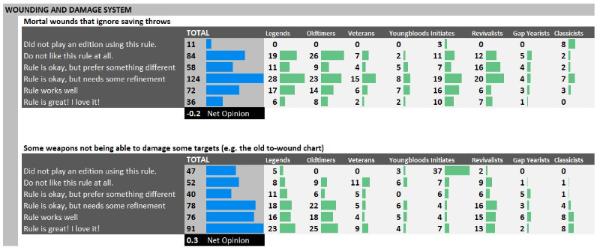
This is an instance where the 8th/9th rule direction trends negative, whereas older editions trend positive. Based on conversations in recent years, I do think there's frustrating tied into the new paradigm of "everything has a chance to wound everything!" and the positive response for the old damage chart maybe reflects that. That said, I didn't ask a question directly about the "new" wounding chart - maybe for next time.
SAVING THROWS, COVER

This is another topic where the items hover around the 0.0 line, where roughly equal numbers of people like and don't like a selected approach. Splitting hairs a bit, but a modifier system for armor pen and the effects of cover is slightly positive, whereas the 3rd-7th edition model of cover providing an invulnerable save and armor pen automatically negating armor trends a little negative. The closeness results still leaves a fair number of people dissatisfied, so it's an area for improvement in the future.
VEHICLE ARMOR & DAMAGE
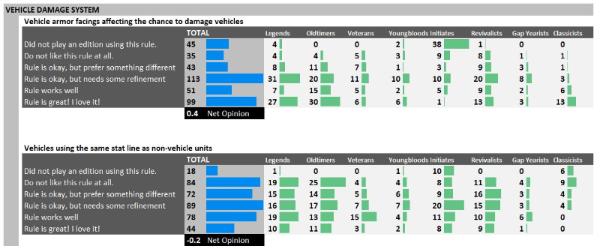
This is another case where the newer 8th/9th paradigm fared more poorly. In conversations, I feel that people want/like the idea of "vehicles acting like vehicles" with armor facings having some impact on how vehicles are damaged being a part of the rules, versus just treating vehicles the same as other models or monstrous creatures.
MORALE
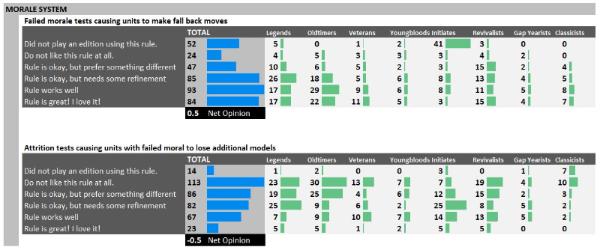
This one is a big swing from +0.5 for the older style of morale with units falling back to the newer approach at -0.5 for attrition effects on failed models. The latter,
IMHO, is a "feelsbad" moment where your unit suffers additional loses in response to already suffering loses just feels wrong.
I didn't get into any questions about sweeping advance rules however, as those changed a few different ways over the course of editions. Probably worth asking about next time, as the "feelsbad" element of the older morale rules is that a unit caught in a sweeping advance is insta-wiped, which doesn't feel great either.
BLAST WEAPONS
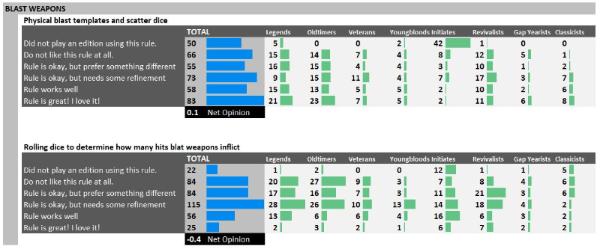
Over there the years there has been no shortage of complaining about blast weapons, templates, scattering, determining if models are fully/partially under the template etc. And much of these seems to be that it was a "fuzzy" aspect of the design that often led to arguments and debates. I get it. What's interesting is that people like the 8th/9th edition way of handling blast weapons even less! There are more that "don't like the 8th/9th way at all" than there are that don't like the old system (84 vs 66). The old way wasn't perfect, but perhaps needed more refinement as opposed to being tossed entirely.
CHARGING AND ASSAULT
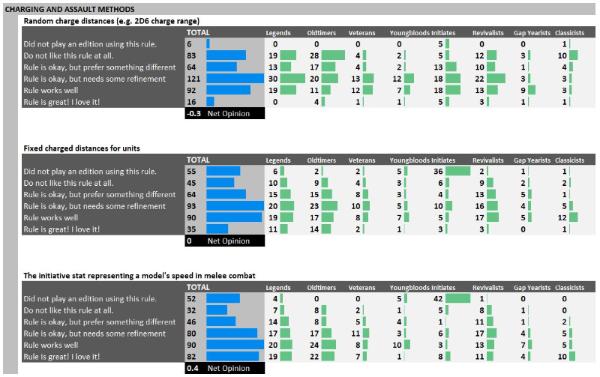
Oh the assault phase... Maybe we're starting to see a trend here, but the older style fixed charges were again preferred over the new random charge distances. Personally, I'm not sure why
GW is so wedded to the idea of random charges. It seems to be an effort to avoid having edge rules to deal with things like charging from deepstrike being too powerful, so they build in a fail chance. But why not just add something to those specific instances instead of adding a fail chance in for a basic unit action? I digress...
Using an initiative stat seems well received.
DEEP STRIKE
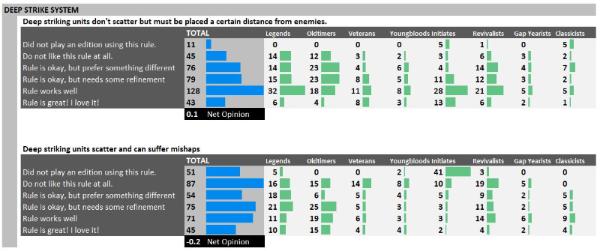
Deepstrike. Oh deepstrike. Such a fun concept crippled by basically poor implementation across most editions. Respondents had a slight positive preference for the 8th/9th non-scatter deepstrike rules (0.1), whereas the older 3rd-7th edition version has a slightly negative preference (-0.2).
Based on conversations and comments, I feel like the dislike for the older system was less about the scattering and more about the possibility for "mishaps" just resulting in a unit being outright deleted. Couple that feelsbad possibility with not having the possibility of charging after a deepstrike either (which 8th/9th allows if you roll well-enough on the charge roll).
SIDE NOTE: Horus Heresy 2.0 rules a modified classic deepstrike role where a "misshap" result lets your opponent redeploy your deepstriking unit within 18" of the original location. Great idea! (cough... I swear this was lifted from ProHammer!)
TURN STRUCTURE
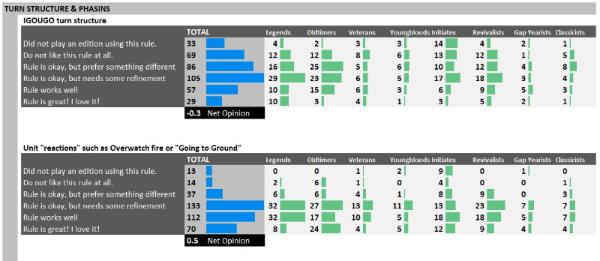
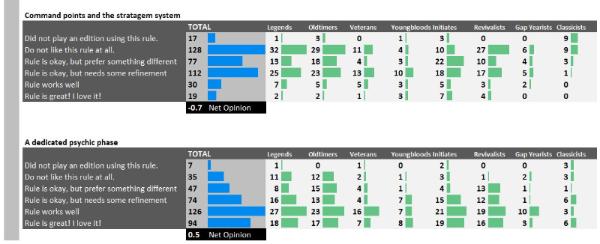
Not much love for the
IGOUGO turn structure, but a pretty strong positive opinion on the idea of "reactions" as a way to mix up the turn structure. HH2.0 may have tapped into this with their proper reaction system.
Command Points are one of the most disliked element in the survey. Strong dislike across the board, but the Legends and Oldtimers (and Revivalists) in particular really dislike it.
A dedicated psychic phase is surprisingly positive - which is a bit curious to me since there's been a lot of complaining about the fiddliness of psychic phases over the years. Need to drill into this one more.
FORCE ORGANIZATION
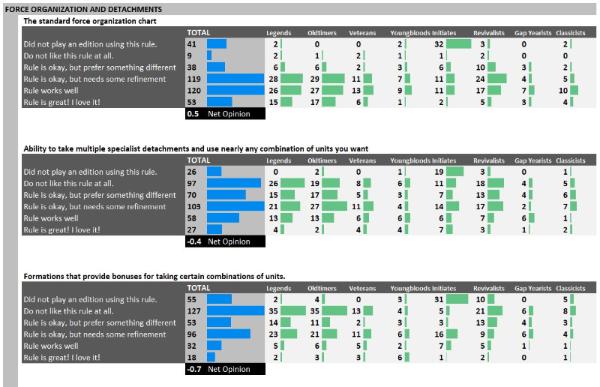
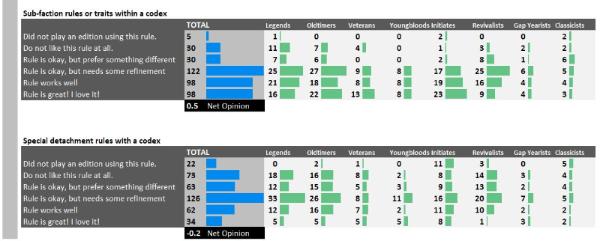
The first comparison is a standard force organization chart versus the multiple-detachment approach used in 8th/9th. Overall, strong (0.5) preference for a standard force org versus disfavor (-0.4) for the multiple detachment system. Perhaps the latter is just too convoluted of a system and/or allows players to skirt around taking a "balanced" force and opens the door to more skew? Not sure, but something worth drilling into.
Formations... Ugh... people really don't like these (another highly negative preference).
The last two, "Sub-Faction Rules / Traits" and "Special Detachment Rules" are interesting. The former is fairly well-received (0.5) whereas the latter trends a bit negative (-0.2). If I had to make a prediction, liking the former is because it gives you an ability to tailor your force at an army-wide level and make something unique feeling. The detachment level rules are disliked, perhaps because they are perceived as a "layer too many" and also intersects with the general dislike of multiple-detachments discussed above.
ARMY CONSTRUCTION
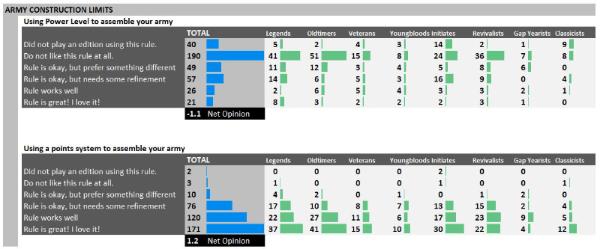
This one is about the most straight forward item. Power level: bad. Points: good. Can we ditch power level already?
MISSION SCORING AND OBJECTIVES
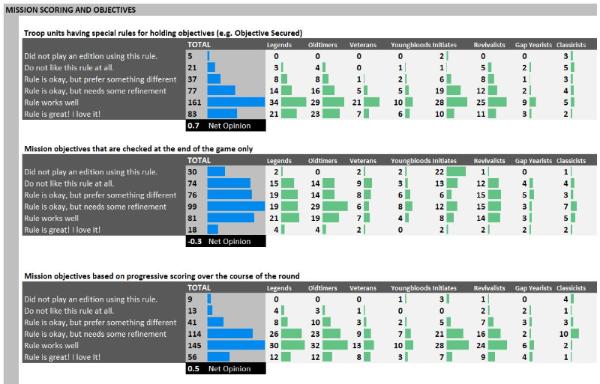
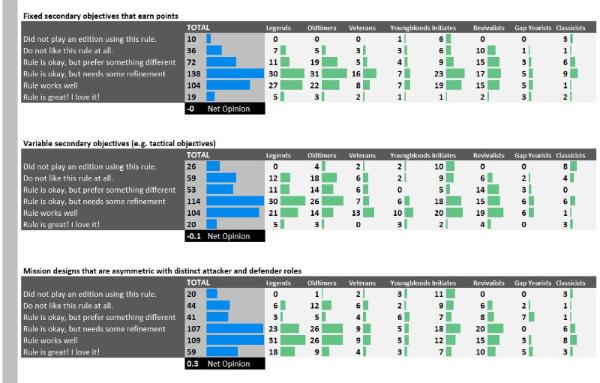
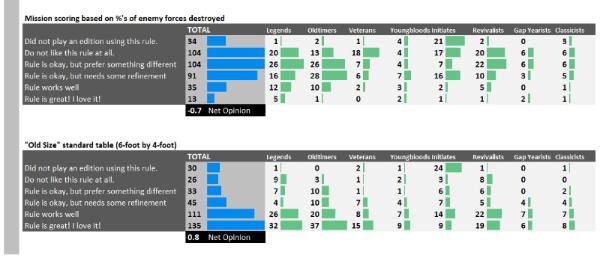
-------------------------------------------------------------
Written Comments
-------------------------------------------------------------
My analysis of this is forthcoming. I have detailed results, by cohort, for each of the 41 items on this list, but that will be a bear to work through and I'll save that for an update in the near future. In the meantime, you can browse the
auto-generated charts here if you want a preview of rule opinion results. You just won't get my commentary yet
